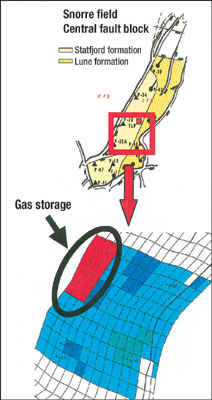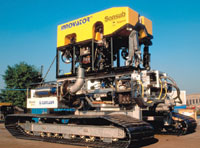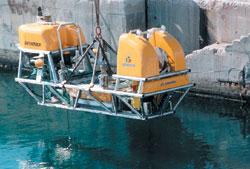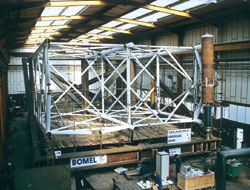European technology round up
Jonathan Shackleton, The Robert Gordon University, Aberdeen
Advanced tracer simulation. Tracer technology is widely used by the oil industry for static and dynamic reservoir characterization, including well communication, fault and fracture detection, flow pattern determination and EOR-methods evaluation. Until recently, however, evaluation of available tracer data remained qualitative due, partly, to lack of software capable of accurately simulating tracer flow within the reservoir. The National Centre for Scientific Research Demokritos in Greece is developing an advanced tracer simulation module (TRACESIM) to improve oil recovery. The overall aim of this project is to update and validate a software tool, the Tracer Module (TM), developed at the Institutt for Energiteknikk in Norway for simulating tracer transport in oil/gas reservoirs, Fig. 1.
Main advantages of the module are reduction of numerical dispersion through advanced numerical schemes, and accurate description of physicochemical properties of the tracers, i.e., partitioning between phases, adsorption to reservoir rock, molecular diffusion and physical dispersion. In this project, the module, coupled to a chemical / thermal reservoir simulator, was upgraded to fit the latest version of the reservoir simulator and was tested on simple 2-D and 3-D generic cases. In addition, the model was validated on selected field cases, where it was used as an integral part of the simulator for history-matching of the well productions, including tracer profiles. In particular, the software tool was used to simulate passive water tracers in Gullfaks field, and water and gas tracers in Snorre field. TRACESIM has clearly demonstrated the value of tracer data in monitoring fluid flow, establishing continuity and quantifying transmissibilities within oil and gas reservoirs. It has also shown that inclusion of such information in the database for the history-matched reservoir model can significantly improve reservoir characterization and understanding of important reservoir properties. Over / under seismic acquisition / processing. In an EC-funded project being undertaken by WesternGeco Ltd., use of combined over / under is being used to provide cost-effective, high-quality 3-D seismic data during bad weather. The aim of the project is to use the combination to achieve high-frequency content typical of a high-resolution survey, with shallow (3-m) cable depth and even-better low frequencies. Recent advances in seismic prospecting equipment, particularly availability of steerable streamer technology, suggested the possibility of performing 3-D over / under. Horizontal streamer steering enables very close and constant streamer separation. This, coupled with a new, highly accurate positioning system based on a fully braced acoustic network, provides the control required for high resolution, optimum coverage and accurate, repeatable survey geometry. In marine acquisitions, shallow source and receivers increase high-frequency content, but attenuate the low frequencies. Conversely, deep source and receivers enhance low frequencies at the expense of high. Over / under can combine, in a single image, the high-frequency content of a shallow acquisition, and low-frequency content of a deeper acquisition. The feasibility study for 3-D over / under acquisition and processing was carried out successfully, and results compared favorably to a high-resolution reference dataset acquired with 3-m cable depth. Over / under can deliver high-resolution 3-D data without need for the perfect-weather conditions necessary for 3-m-depth acquisition. In the 3-m data bandwidth, over / under and 3-m data show a high degree of similarity. Further, over / under exhibits better low frequencies. Trenching, cable maintenance system. As the telecommunications industry moves into the next millennium and into increasingly deeper waters, technological challenges increase, both in frequency and significance. The oil/gas business has responded by developing the Centaur trenching system, a more flexible and cost-effective alternative to traditional subsea-cable maintenance systems.
The Centaur project, funded by the EC within the THERMIE Program, is an extension of Sonsub’s internal development / production of the 3,500-m-depth-rated Innovator remotely operated vehicle (ROV). The system combines an ROV with a tracked trenching skid (ITS), Fig. 2. The breakthrough is the ROV’s capability to mate and un-mate underwater with the ITS, thus enabling the ROV to perform as a free-swimming ROV, or as the primary power source for the seabed tractor. This allows the system to accomplish various survey, maintenance and burial tasks as a combined unit, or as a separate ROV system. During conceptual design, it was recognized that the system’s innovative advantages must not compromise the ultimate objective, which is trenching performance. To this purpose, the jetting tool is supported on a tracked base, specifically designed to deliver the necessary stability and bollard pull to promote consistent burial performance. A passive water-jetting system achieves trench formation by means of two independent trenching tools. The Centaur system has now successfully completed a number of post-lay inspection and burial projects, proving merits of the concept in both shallow and deepwater applications. Hybrid AUV-delivered ROV. SWIMMER is another ROV technology, led by Cybernetix of France and supported by the EC. This project operates a standard ROV for inspection, maintenance and repair (IMR) tasks on ultra-deepwater fields. What is innovative is that this is achieved without need for long and heavy umbilicals, and special support vessels with all their associated costs, and without reducing the global work capabilities of the system. The concept is to shuttle the ROV in an "autonomous" mode, using a special autonomous underwater vehicle (AUV), from surface to a subsea docking station located close to the equipment requiring intervention, Fig. 3. When the AUV shuttle is docked, underwater-mateable connectors link the ROV to a pre-installed power and control umbilical. This is integrated into the field’s permanent production umbilical so that it can be operated from surface like a traditional ROV system.
This innovative concept – which can be thought of as a hybrid AUV/ROV – means that: 1) full work capabilities of the ROV are preserved because the system can deploy any type of conventional work ROV; 2) the field’s subsea equipment, such as wellheads and manifolds, do not require modification to enable intervention by SWIMMER; and 3) it is possible to retrofit an existing field. Strength analysis extends offshore-structure life. BOMEL Ltd. in the UK is working on an EC-funded project to enable structural system strength reserves to be utilized reliably to improve safety / economy of offshore structures. The aim is to assist in extending platform life and designing efficient lightweight structures for deepwater and marginal fields. The project carried out the first 3-D-frame-collapse test ever to be undertaken at sufficient scale to validate both the methodologies and innovative software for predicting ultimate response and reserve strength of offshore structures. The test structure was scaled to about one-third the size of a Southern North Sea jacket, with components proportioned / fabricated to be representative of offshore practice, Fig. 4. The tests provided, for the first time, a clear demonstration of the way 3-D tubular framed steel structures respond under extreme loads. This will assist in the design of new, lightweight and cost-effective structural forms. In addition, it will assist in assessing system strength for existing structures, and indicate whether they can sustain additional load without need for strengthening or repairs. Ongoing integrity management will also benefit, as work can be prioritized to focus on those components critical to maintaining overall system performance.
Controlling lifted-load swings. The University of Strathclyde has been working on an active pendulation control system (APCS) to reduce the swing of suspended loads during offshore lifting operations. One of the biggest problems associated with lifting operations offshore is the swinging motion of the load, caused by vessel motion and normal actions of the crane operator. The uncontrolled motions of a suspended load can present a risk of injury to personnel and cause serious damage to the vessel or its associated equipment. Such motions are often the critical factor that limits offshore lifting operations. This is obviously detrimental to overall offshore-system operability. The APCS employs an innovative active control system to overcome limitations of both manual and passive pendulation-reduction systems. It also uses a number of inertial sensors attached to the mother vessel and the crane, which provide inputs to the APCS software. Command signals are derived and used to drive the crane boom tip in such a way as to virtually eliminate all lateral swinging motions of the load. The system controls both luffing and slewing motions of the crane. The prototype system was shown to work on two typical offshore support vessels and results obtained suggest that moving to a larger vessel – which would have smaller and lower-frequency motions – would only improve system performance. It is envisaged that the system will have its main market on cranes with a 10-mt to 50-mt capacity. Further information on projects in this article can be obtained by e-mailing Jonathan Shackleton at j.shackleton@rgu.ac.uk. Several technologies supported by the EC will be shown at the 2002 Offshore Technology Conference, Houston. |
||||||||||||||||||||
- Mixed outlook for activity on the UK Continental Shelf (December 2023)
- First Oil: Sorting through the muddled mess (November 2022)
- First Oil: Electricity problems reflect poor energy/resource policy (August 2022)
- First Oil: A tale of two “windfalls” (June 2022)
- The ESG perspective: A day without oil? (April 2022)
- Executive viewpoint: Texas oil and gas can save Europe—again (April 2022)
- Applying ultra-deep LWD resistivity technology successfully in a SAGD operation (May 2019)
- Adoption of wireless intelligent completions advances (May 2019)
- Majors double down as takeaway crunch eases (April 2019)
- What’s new in well logging and formation evaluation (April 2019)
- Qualification of a 20,000-psi subsea BOP: A collaborative approach (February 2019)
- ConocoPhillips’ Greg Leveille sees rapid trajectory of technical advancement continuing (February 2019)







